I started writing this after seeing a Bufflehead earlier than I’d ever seen a Bufflehead. Then I sat on the draft for quite some time, and kind of forgot about it.
Bufflehead aren’t unexpected anymore. I awoke Thanksgiving day to look for ducks and other birds in the nice light. Plenty of waterfowl. Mallard of course. Ring-necked Duck, Bufflehead. Aside from waterfowl, I enjoyed some Dark-eyed Junco—called “snowbirds” because of the time of year they become abundant. Also got a good look at a Carolina Wren. As always, it made me smile. That voice, that eyebrow.
As I do whenever I’m out looking for waterfowl, I was hoping for a Wood Duck. I’d been alerted to a Wood Duck drake at this spot. No dice. Wood Duck or not, in a cliche moment I watched the ducks milling about and thought: I am so thankful for ducks. It was Thanksgiving after all.
Species names of certain birds seem apt. (e.g. Ruddy Turnstone, a ruddy bird that turns stones.) When you see a Bufflehead, it’s satisfying to think: Bufflehead.
It feels descriptive, though not so explicitly as Red-tailed Hawk. With a name like that you know the bird in question is a hawk, likely with a red tail—though there are “even Red-tails without an actual red tail.”
We won’t get into that. This is about ducks.
Bufflehead. A subtly goofy name for a subtly goofy bird.
It’s pleasing, but isn’t onomatopoeic based on what the bird sounds like—as with Eastern Phoebe, Whip-poor-will, Eastern Wood-Pewee. The Bufflehead’s vocalizations don’t sound remotely like “Bufflehead” or even just like “Buffle.”
They make a “squeal or growl,” and they “often give a grating or chattering call during their head-bobbing courtship displays.” The female makes “a guttural cuk-cuk-cuk call when circling around potential nest sites.”
That is if they make a sound at all. Bufflehead are quiet.
“Bufflehead” comes from “buffalo head” because the head is large and puffy. Maybe that’s why the name sounds as descriptive and pleasing as it does.
The duck’s head courts your attention, there is white set against the black. This white is more prominent with males; a female just has a white spot by the ear, as do immature males.
As much as I love to bird by ear, I don’t do it for ducks. I’m just not well-versed in duck calls. Love a Northern Pintail, Greater Scaup, a Gadwall, a Ring-necked Duck, but I don’t specifically know what any of them sound like.
The way I might sing an Eastern Screech Owl’s song to myself—as I do every time I read that—I can’t do that with duck calls. Probably because they don’t “sing.”
Plus, in my experience, some ducks aren’t super vocal. I’ll also guiltily admit there’s less allure to duck calls than birdsong. Would I rather listen to a quacking Mallard or the familiar beauty of a singing Black-throated Green Warbler? Not a hard choice.
I’ve only ever birded by ear for waterfowl to find Wood Duck, which have a distinct call. When I first learned it, my reaction was: “Doesn’t sound too duck-like.” Perhaps partly the appeal.
The female Wood Duck’s call is described in my Sibley as “a penetrating squeal ooEEK ooEEK . . . ; also a raucous quack, rarely heard.” Contrarily, the male has “a thin, high, drawn-out jeweep or sweeoo, kip, kip, kip.”
Appearance-wise the male is more striking; a Wood Duck drake is famously handsome. Call-wise the female takes the cake. Birding by ear, there’ve been times I’ve heard a female Wood Duck, that “penetrating squeal,” but then saw the drake. They’re eye-catching. “That duck was all jewels combined,” wrote Thoreau of the Wood Duck drake. My waterfowl guide calls the bird “about as ornate as possible.”
The first sentence of the Bufflehead entry in that same guide is: “Yes, the Bufflehead is cute.” No argument here. Aside from being petit and endearing—“a very flashy little duck,” says Sketches of New England Birds—they are interesting.
Bufflehead nest in cavities. Because they are so small, the smallest diving duck, they are the perfect size to use the old cavities of Northern Flicker. Being perfectly small for these cavities results in less competition with other cavity nesters, like the Common Goldeneye of the same genus.
The guide goes on to explain that some call the Bufflehead “spirit duck” because of its penchant for floating “buoyantly, like a beautiful apparition, on the smooth surface of the pond or quiet stream.”
Having spent plenty of time watching Bufflehead, I can think of another way “spirit duck” seems fitting. You’ll be watching one of these birds, look away for a second, look back and it’ll have disappeared. Gone for quite a while, it’ll pop back up somewhere new. There, then gone—like a spirit.
This is because a Bufflehead can dive for quite some time. Sketches of New England Birds draws the comparison: these birds go into “a smooth dive and then [reappear] some distance away, bobbing to the surface like a little black-and-white cork.”
I’ve searched for an exact figure for how long a Bufflehead’s dive lasts, but they vary. Twelve seconds, over a minute, thirty seconds—so I will just rely on my lived Bufflehead experience and guess longer. We’ll say over a minute. Often one will dive, be submerged and out of sight. Then, when you’ve mentally moved on from the duck, you’ll see one break the surface in a new spot. Same duck? Different Bufflehead? Probably the same one, but hard to be certain. A spirit duck.
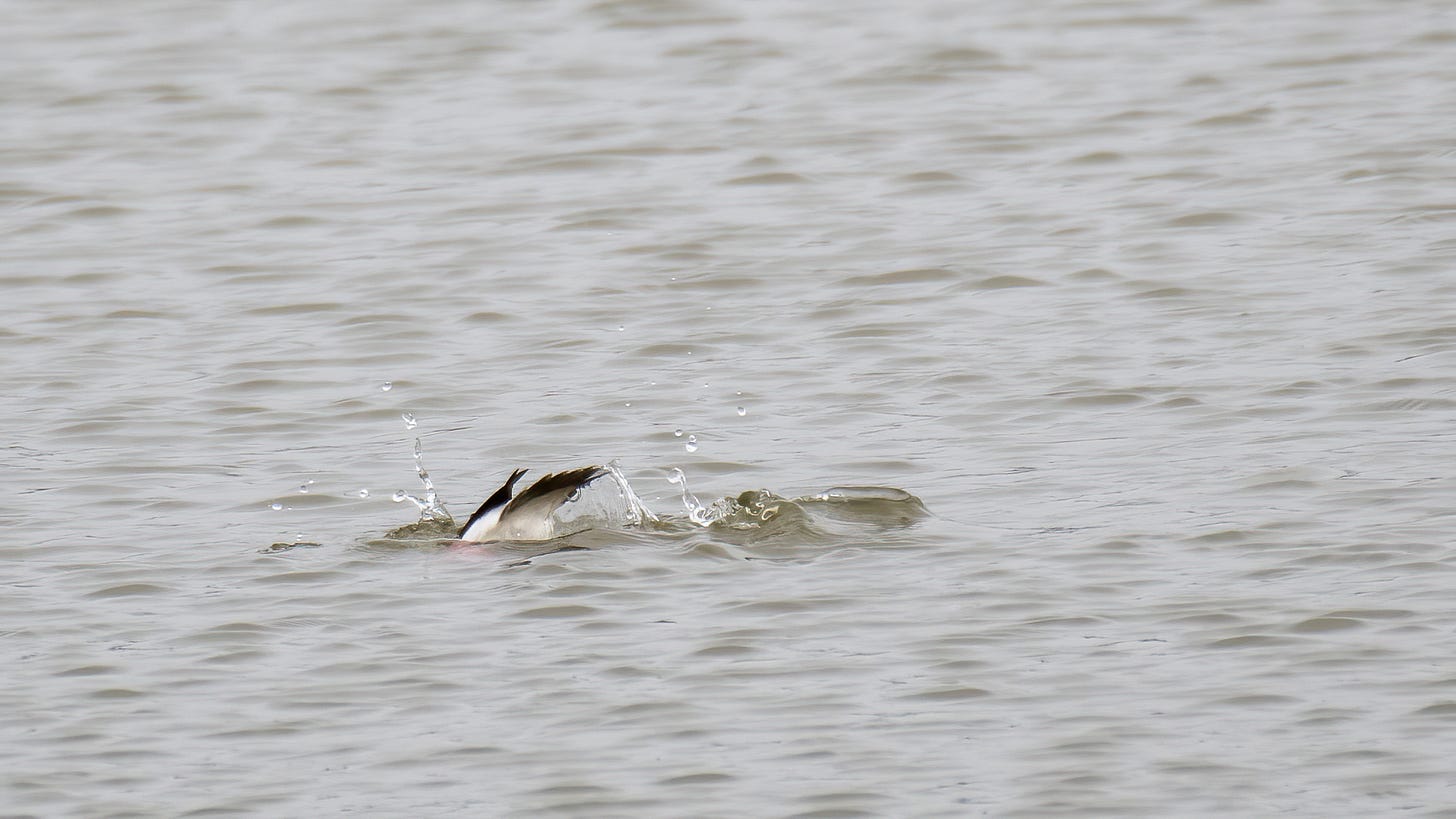
I am guilty of sending memes to friends. Sometimes they’re memes about birds. I was once sent one about correcting people who say “seagull.” Felt both seen and attacked.
Months later, somebody said “seagull” to me. As is apparently my wont, I explained they were technically “gulls.” Then thought: Oh, yikes. I actually do that.
Gulls aside, with waterfowl season here one bird meme I saw a while back sticks in my mind: Sisyphus rolling his rock, labeled “My respect for ducks,” up a hill labeled “Society.” Often, yes. Ducks, gulls, birds at large.
Ducks don’t put on airs—no bird does. A Blackburnian Warbler doesn’t change anything to excite a person who sees one, it’s just beautiful with that orange throat. Thrilling at face value. A Bufflehead doesn’t alter any behavior either, but can take a little more awareness to be awed by. Their face value is less immediately grabby.
Ducks are ducks. You get to interestedly watch them be ducks and go about their business, or you can pass them by disinterestedly. Makes no difference to a duck. If you do the latter, your loss. A duck isn’t going to court you. As with all birds, this indifference makes me respect them. I might love a duck, but a duck doesn’t love me. To a duck, none of us matter. But does a duck matter to you? To me, they do.
Writing this about Bufflehead is an act of respect for ducks. One of many to come. Sometimes writing feels smoother; writing this about a duck has felt natural. It feels that way because I love ducks—respect them, with or without society’s understanding. It’s exciting this time of year will bring more acts and moments of duck respect.
When I began writing this, a trail had just opened for the fall and winter where I once saw Harlequin Duck—male and female. I wanted to go for a walk, enjoy the day, so went there.
It was still early for Harlequin Duck, but a walk is never a bad idea—even if my favorite pictures from that walk are of a Laughing Gull, House Sparrow, and a cabbage white butterfly. Some subpar pictures of monarchs. Nothing too exciting. “This may be our most common butterfly,” says one of my butterfly books of the cabbage white.
Butterflies are something I have been reading about, broadening my winged horizon to include more than birds. As I learn about them I will write about them—starting with the basics. Say, how are butterflies different from moths? Still, no matter how much I come to feel acquainted with butterflies, walk this trail, maybe see monarchs (not this time of year), in my head it will always be the trail of the Harlequin Duck.
As it was early for Harlequin Duck, it was early for Bufflehead. Not anymore. Even if I didn’t see a duck that day, they excited me. A tee shirt of mine features duck species. I believe I have three duck shirts. What can I say? I respect them—and many of my shirts are bird shirts. After my walk, I wore my original duck shirt and thought: “Soon.”
Getting excited about a duck in early fall felt like getting excited to eat a meal that wasn’t finished cooking yet. Now, December, that meal is done. Ironically, the meal that comes to mind is also duck. On water or a plate, these birds make my life better.





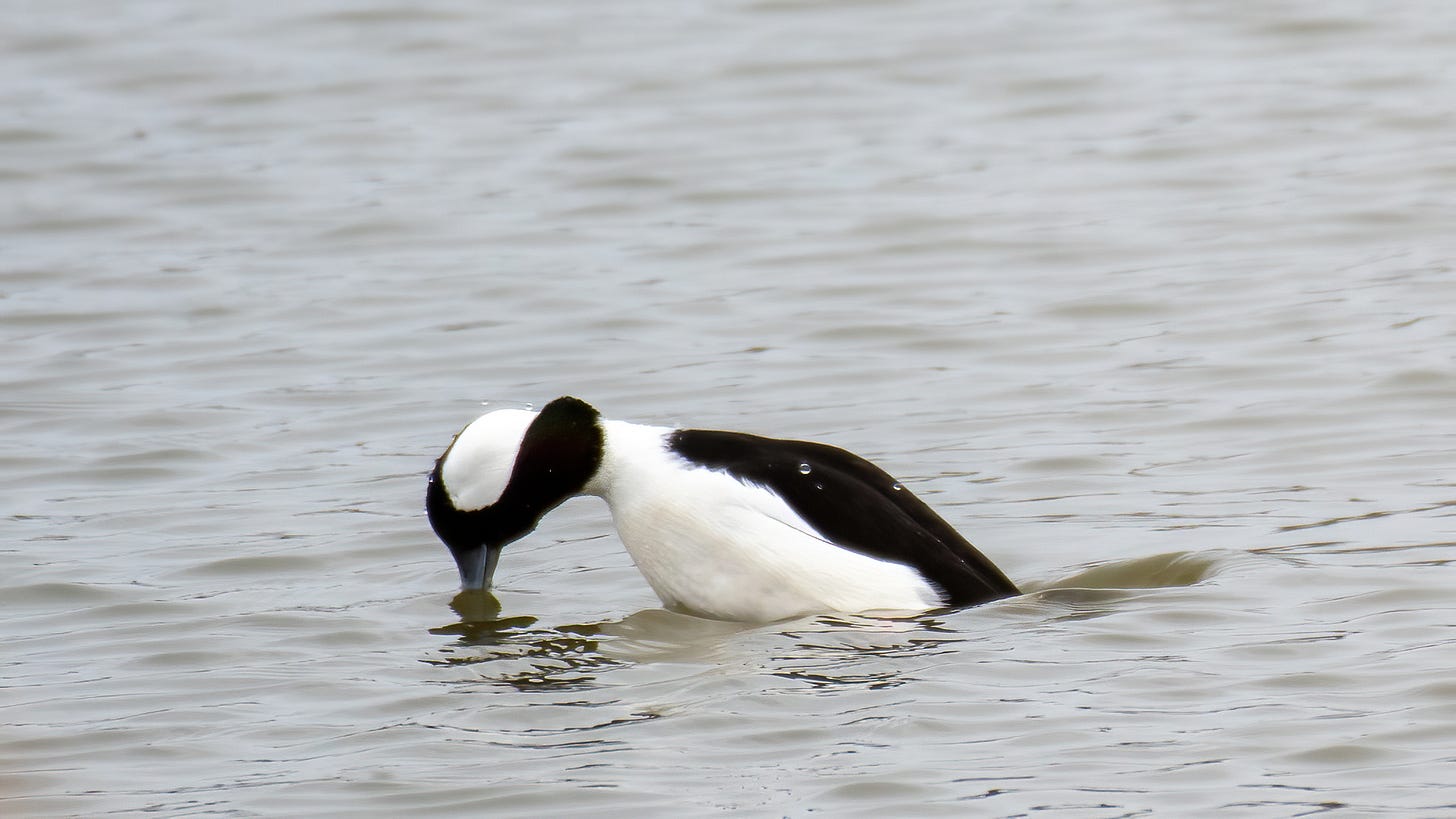

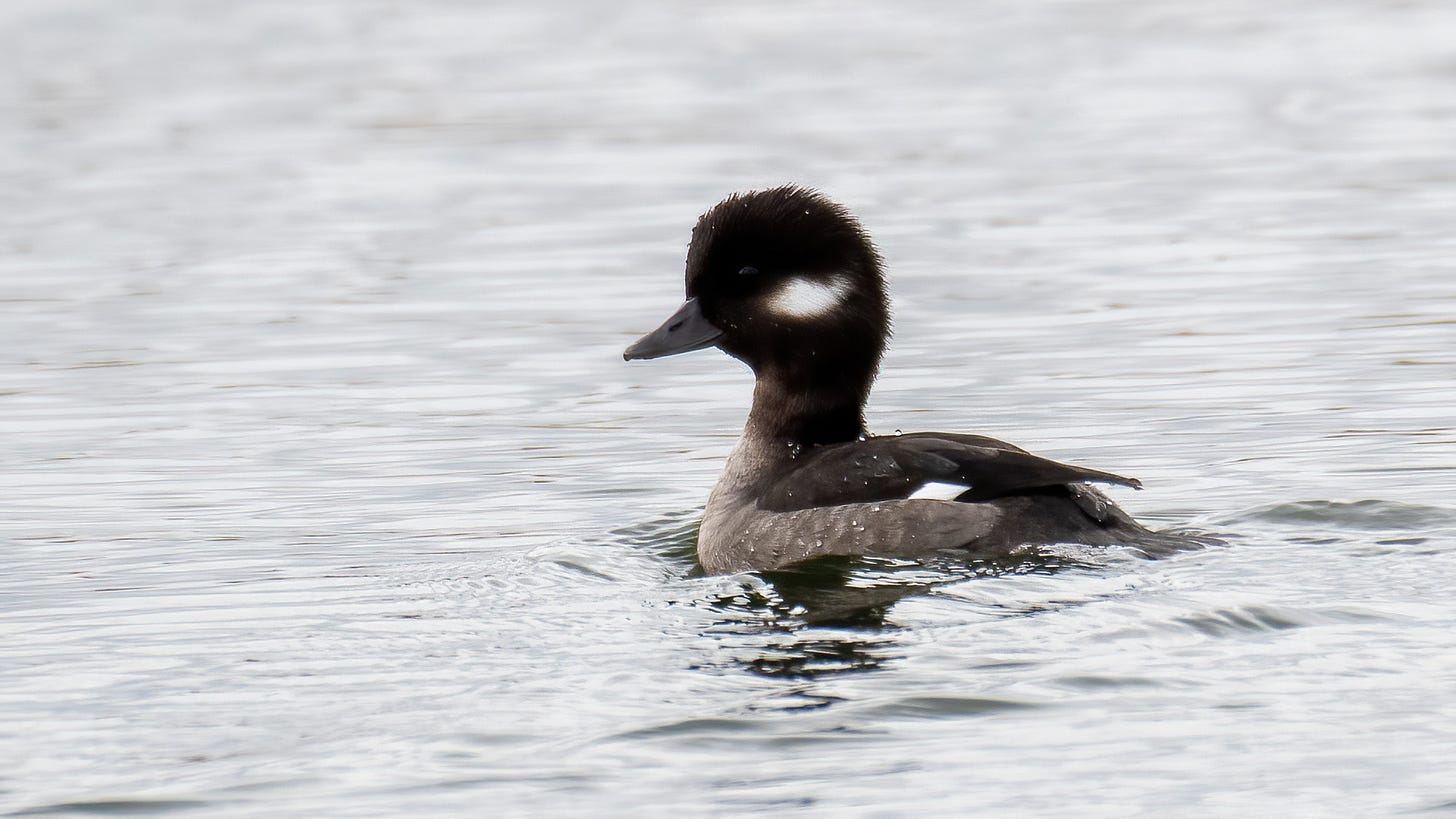
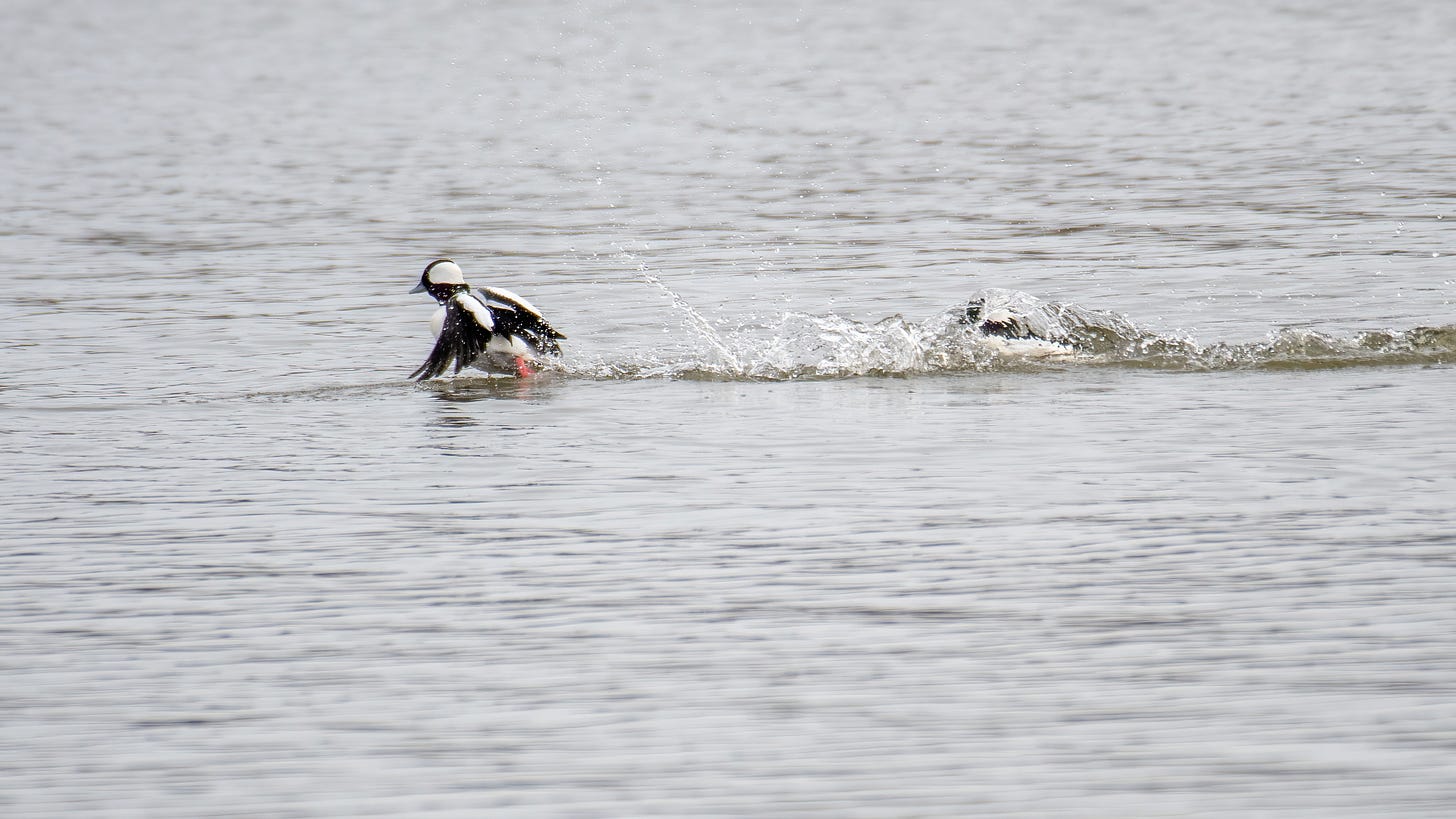


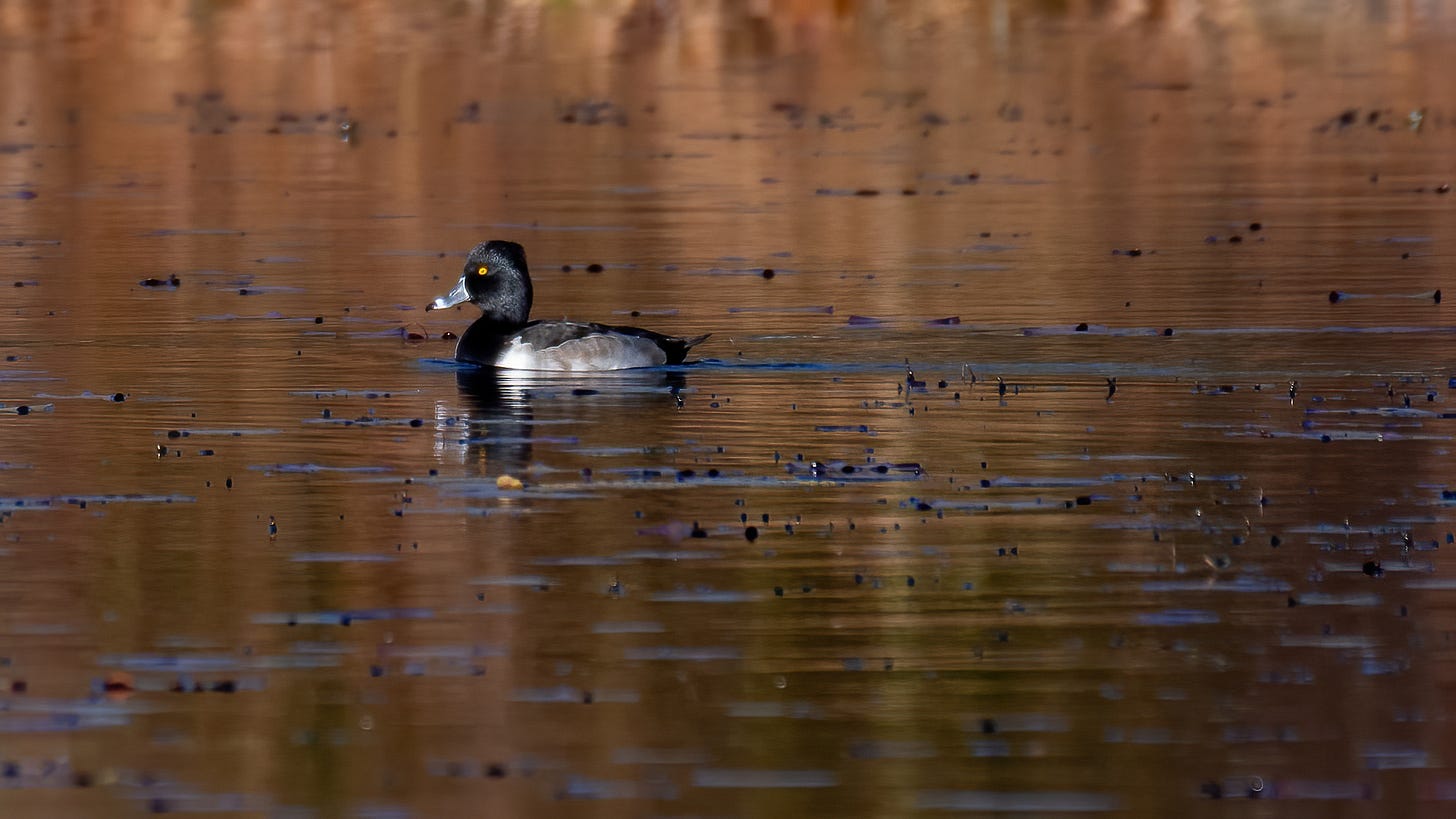

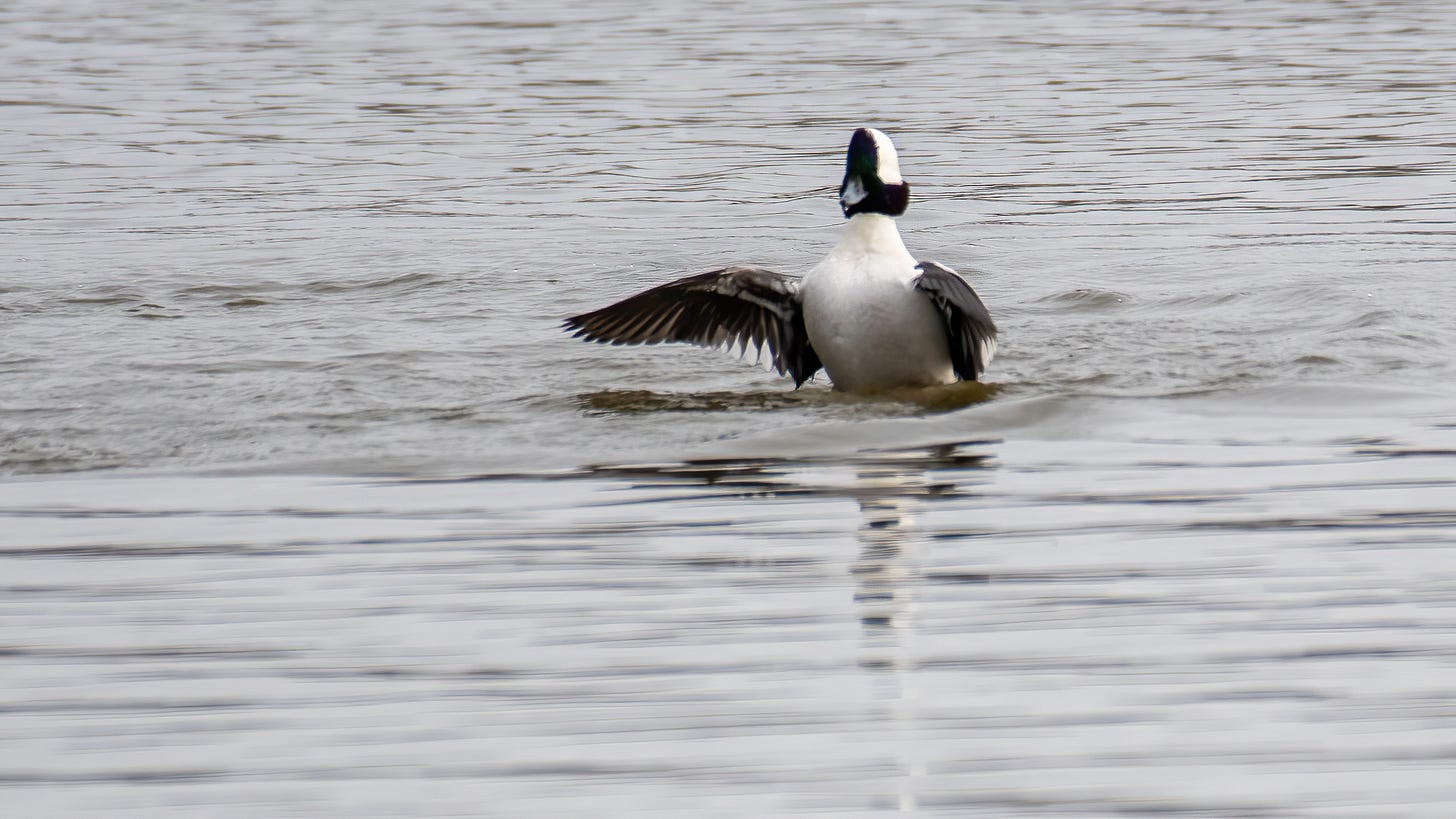


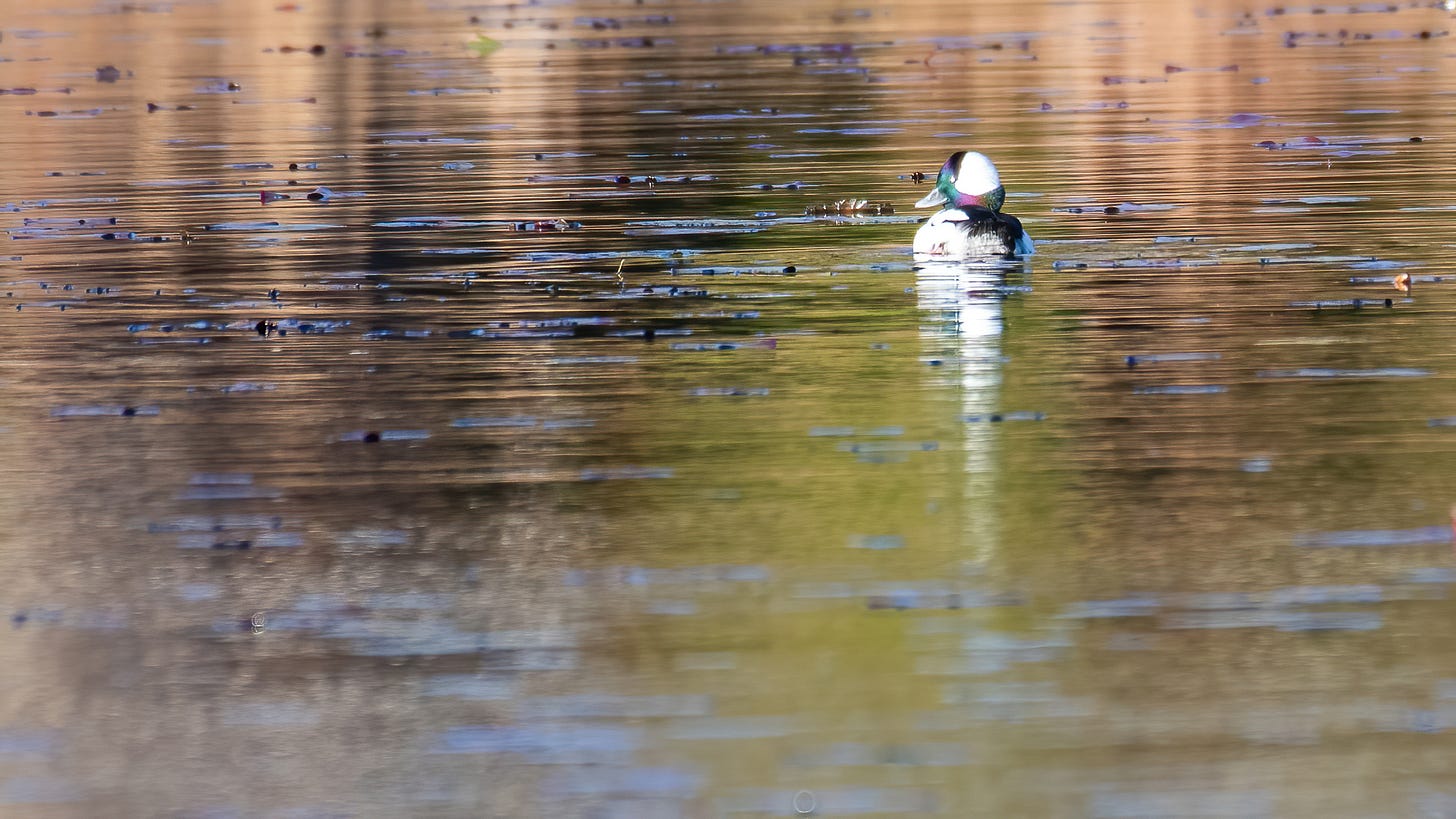

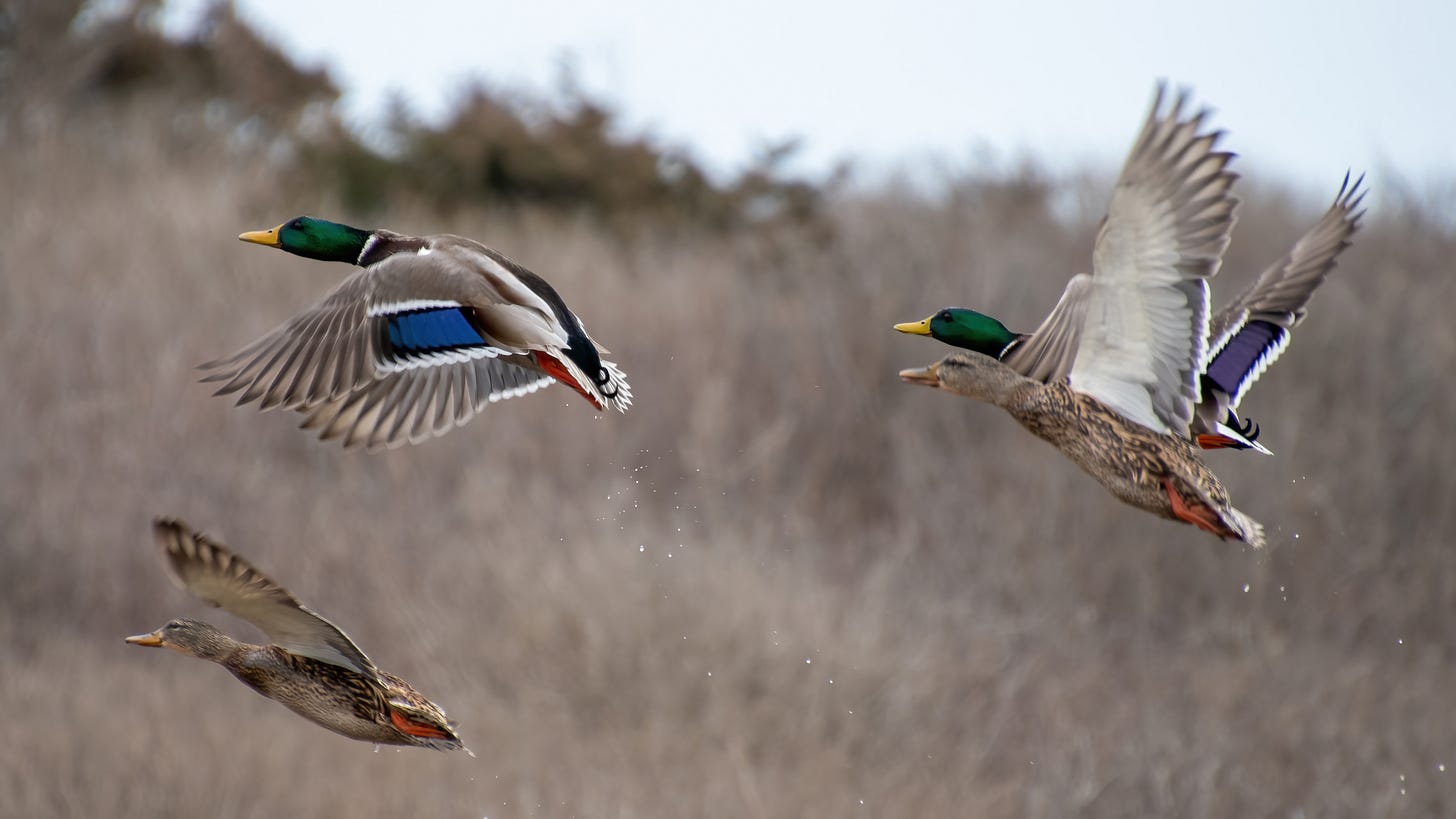
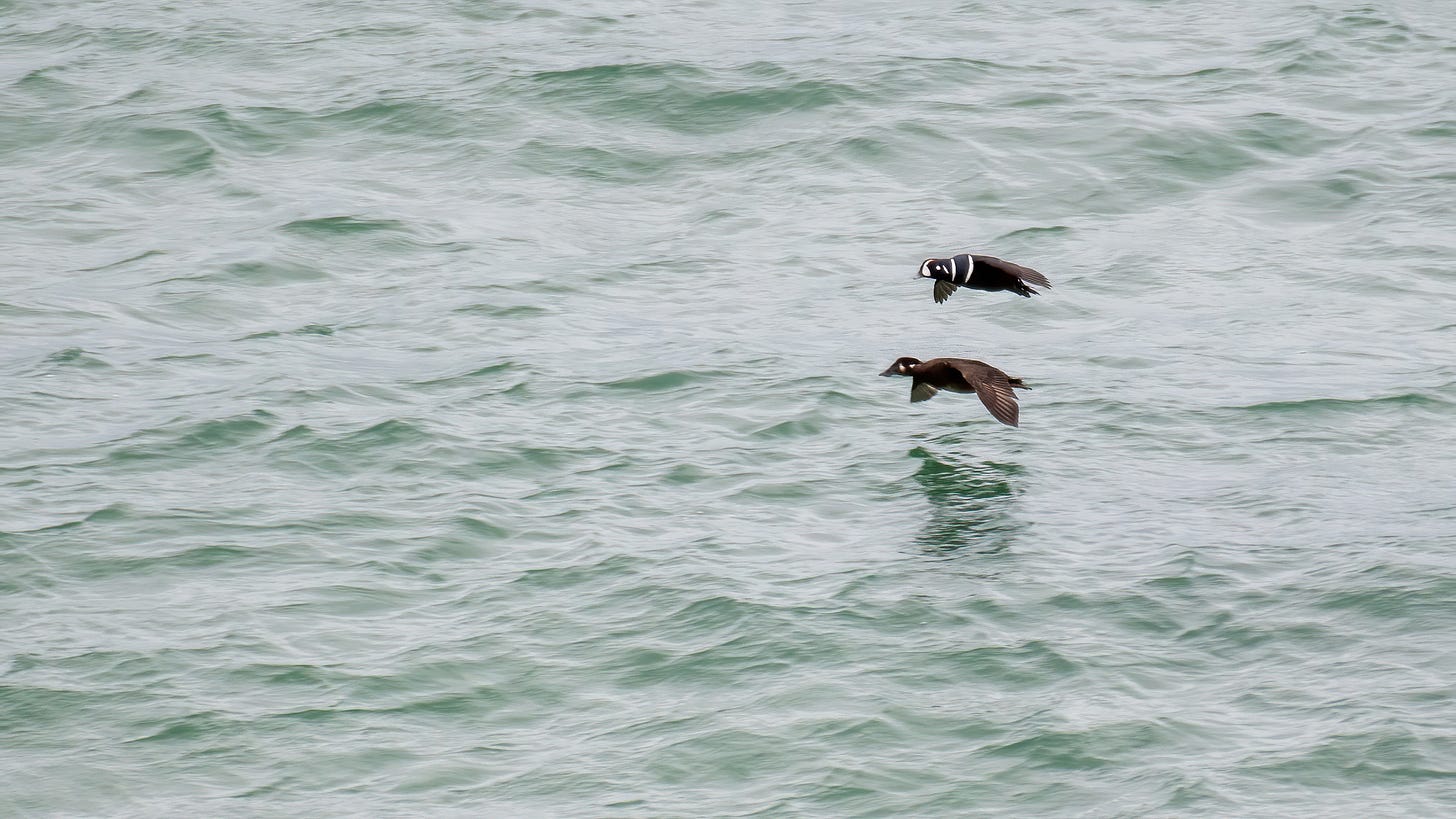
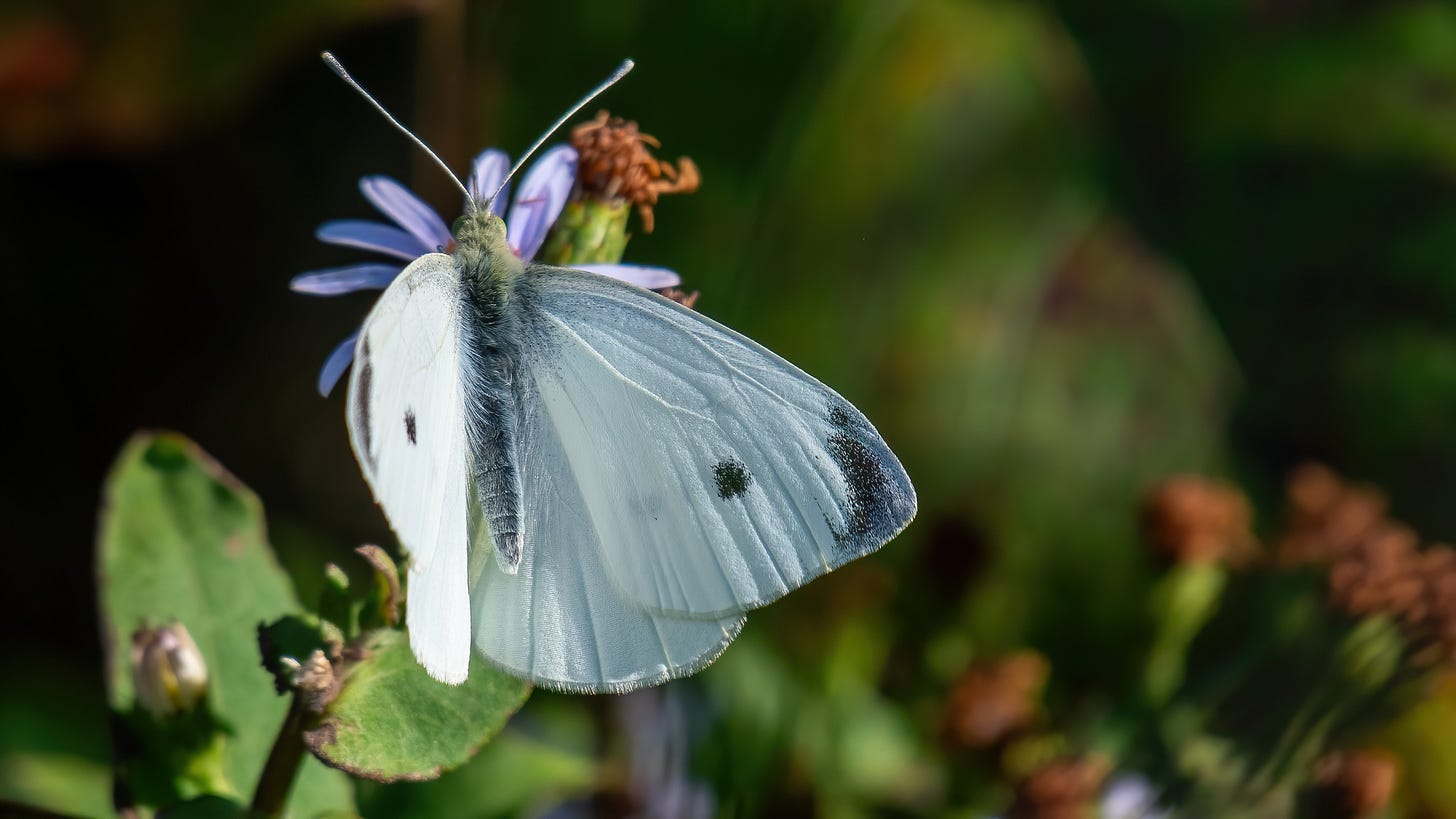
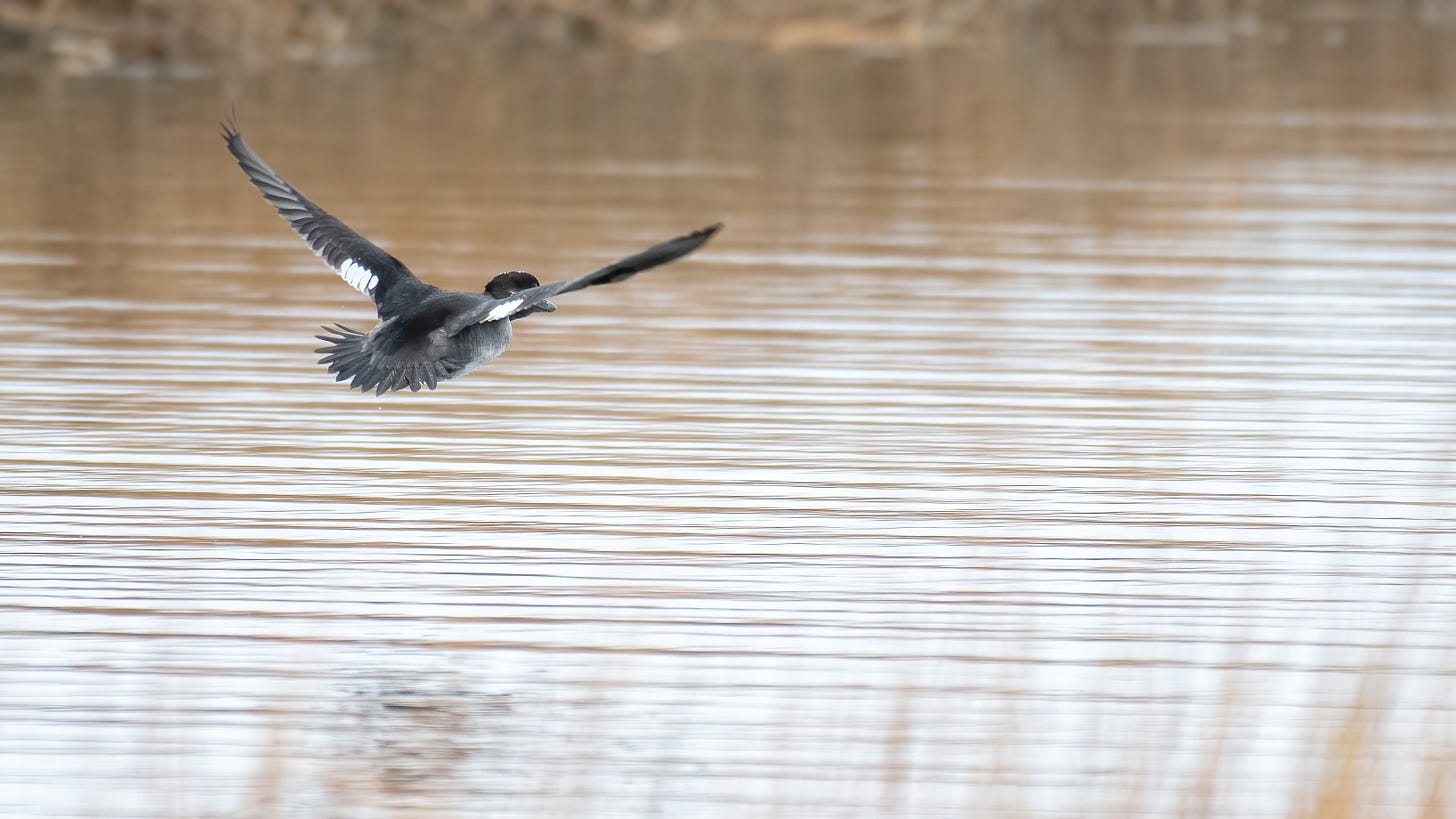
Excellent post about waterfowl I know very little about. Bufflehead does seem like such an odd name for them. Great photos - especially like that photo of the pair of Harlequin Ducks in flight.
Thank you, Neil! Those ducks were so far off I didn’t realize they were Harlequin right away until I reviewed the shots on the camera’s little display. Hope to see more.